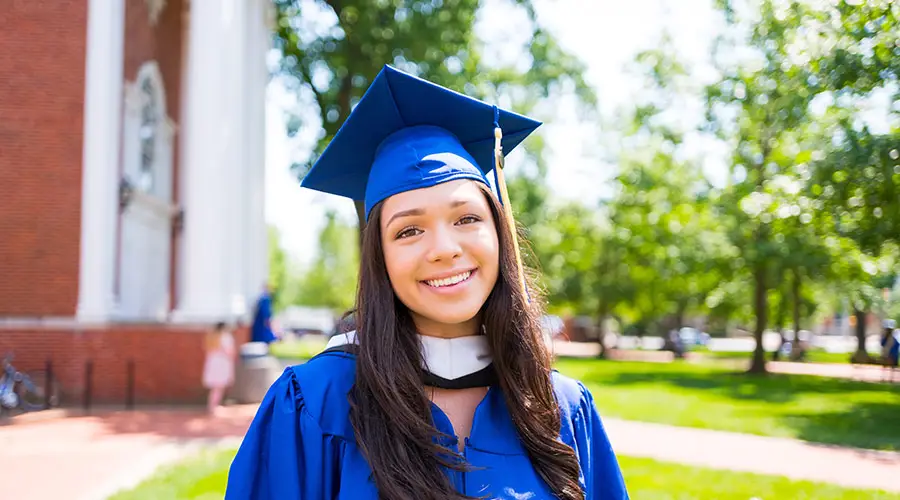In 2022, according to data from the Hispanic Association of Colleges and Universities, Latino students received more than 16% of the bachelor’s degrees awarded that year, an increase from 9.2% in 2011. However, compared to their white counterparts, Latino college students are falling short in regard to the percentage enrolling in college vs. graduating.
For example, in 2021, only 33% of Latino students enrolled at two-year institutions in California finished their degrees, and at four-year institutions, only 58% finished their degrees. For white students, the numbers were 43% and 70%, respectively. The percentages were similar in several other states across the country with a significant Latino population, creating a significant gap in higher education.
Ahead, we discuss the importance of closing the gap in Latino higher education and how that can improve outcomes for the Latino community and the U.S. economy. We also dive into organizations that are helping to close gaps in higher education, such as Community College Bachelor’s Programs.
The Importance of Closing the Gap
According to the same data from the Hispanic Association of Colleges and Universities, almost four million Latino students were enrolled in higher education institutions in 2022. Unfortunately, many of those students contend with barriers to completing higher education, such as tuition costs and housing. This means that Latino students are at a higher rate of initiating degrees but not completing them.
Closing the higher education gap for Latino students is important for many reasons. First, it can help meet rising workforce demands. A 2018 report by the Campaign for College Opportunity notes the Latino population in California is expected to rise to 45% by 2060. Since the Latino population comprises California’s largest ethnic group, the education of Latino students is crucial to the economic future of the state.
Moreover, higher education for Latino students can lead to better economic security for these students, their families and their communities. Increasing the presence of Latino students also creates a sense of belonging on college campuses and helps to strengthen diversity. In addition, increased representation of Latino leadership, faculty and mentors in higher education can help close critical gaps for Latino students and help these students prosper.
How Community College Bachelor’s Programs Are Helping to Close Education Gaps
In 2014, California passed a law enabling community colleges to launch two-year bachelor’s degree programs, an alternative to receiving a bachelor’s degree at a four-year institution. This law led to the creation of Community College Bachelor’s (CCB) Degree Programs.
CCB Degree Programs make college more accessible and cost effective and prepare students for high-demand and sought-after careers, including health information management, automotive technology, aviation maintenance technology and respiratory care. Key objectives of the CCB programs are to help meet workplace demand and confront unfulfilled student demand for post-associate degrees. CCB programs are focused on specific occupations rather than the more comprehensive degrees offered at four-year colleges and universities.
Within the first five cohorts of the CCB degree programs at California community colleges, 64% of Latino students graduated with bachelor’s degrees after two years of enrollment, compared to 68% of their non-Latino counterparts. A major contributing factor to these graduation rates comes down to the affordability of the programs and the time it takes to complete the program.
Recorded outcomes regarding labor market experiences also noted that Latino graduates of CCB programs received over $22,000 more per year in earnings after completing the program Graduates also saw increased levels of employment, with 94% of graduates securing jobs soon after graduation.
Furthermore, borrowing rates among Latino graduates of California CCB programs were lower than the overall California loan borrowing rate for Latino students and students from other ethnic groups.
There were fifteen participating community colleges with CCB programs in the inaugural class, including Santa Ana College, Modesto Junior College, Cypress College, Santa Monica College and Rio Hondo College. As of 2023, 31 approved CCB programs exist in California.
More Organizations Closing Gaps in Higher Education
In the same vein as CCB, there are several organizations working to close gaps in higher education for those who lack access to opportunities, including Student Freedom Initiative (SFI) and the internXL program.
Student Freedom Initiative
Founded on the heels of philanthropist and entrepreneur Robert F. Smith’s life-changing gift to the Morehouse class of 2019, SFI helps shape the leaders of tomorrow by providing access to education without burdening students and graduates with overwhelming debt.
Smith’s intention was to create a scalable solution to the crushing nationwide student loan debt crisis, alleviating the burden on professional and life choices, as well as social and economic mobility. Student funds are granted through the Student Freedom Loan Agreement, an income-contingent alternative to financial assistance programs like Parent PLUS loans.
The organization also works to approach the wealth gap through the lens of education, partnering with Historically Black Colleges and Universities (HBCUs), other Minority Serving Institutions (MSIs) and Tribal Colleges and Universities (TCUs) to increase access to broadband and close the digital divide on these campuses and in surrounding communities. SFI also boosts cybersecurity measures and aims to fulfill green energy efforts at these institutions.
internXL
SFI also partners with the internXL program to assist students in gaining access to skill-building paid internships with leading STEM, financial, marketing and software companies. It prepares participants with career readiness training and offers mentorships and networking opportunities with senior-level executives. The program aspires to develop a more diverse and inclusive workforce.
Follow Smith on LinkedIn for more information on bridging gaps in higher education.
